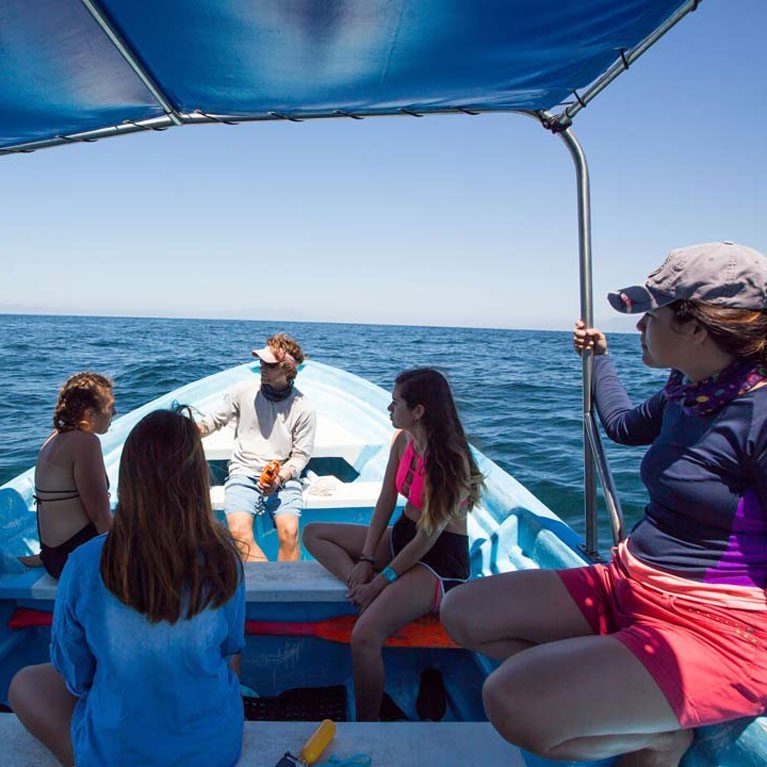Nurturing shark and ray science in Mexico
Bahia de Banderas, a large bay on Mexico’s pacific coast attracts large numbers of oceanic mantas. Josh is working with local undergraduate students to learn about the rays. The students gain valuable research experience and career support and the programme also runs outreach with local schools.
I grew up as a city kid from New York, far from the tropical oceans where I now work. My escape was the American Museum of Natural History, where I would spend hours in the Hall of Ocean Life staring at frozen tiger sharks chasing sea turtles or lying on the floor examining a life-size blue whale suspended from the ceiling. As a teenager, I took every available opportunity to volunteer for research and conservation projects and went swimming, diving, sailing, kayaking – anything that would get me into the water. When I started college, I enrolled in classes on...
Capacity Building Workshop for Young Elasmobranch Scientists in Pacific Mexico
Our goal is to engage local students in elasmobranch research and conservation, equipping them with the practical skills necessary to pursue graduate education and fill critical knowledge gaps that will lead to improved management of elasmobranchs in Pacific Mexico.
Elasmobranchs in Pacific Mexico are threatened primarily by artisanal fisheries and bycatch in commercial tuna fisheries. Manta rays were essentially wiped out in the Sea of Cortez in response to targeted fisheries in the 1980s and ’90s, and are threatened by accidental entanglement in fishing gear in Bahia de Banderas. Mobulas are caught by artisanal fisheries in Baja California and by industrial purse seiners targeting tuna throughout Pacific Mexico, and the impacts of these fisheries on mobulid populations remain largely unknown and poorly studied. Other elasmobranch species such as thresher and mako sharks as well as a wide variety of batoids and benthic elasmobranch species are targeted throughout the Pacific coast of Baja. Currently there is insufficient local conservation and research capacity to address the numerous knowledge gaps and pressing elasmobranch conservation priorities. Young Mexican scientists with field, laboratory, and analytical skills are necessary to further elasmobranch research and conservation.
Threats to oceanic manta rays in Bahia de Banderas include boat strikes and entanglement in discarded fishing gear. Our current project in the region aims to identify the seasonality of manta presence and abundance in order to inform time/area closures that would prevent or mitigate these major threats. We have been including 6 local students directly in this research over the past year, and we have involved over 20 other local students on a short term basis. We have also worked with two university students from La Paz, Baja in our research on mantas at the Revillagigedo Islands. The majority of their participation has involved training in field research methods, and our goal is to provide them with more in-depth training in conservation research methods that will facilitate elasmobranch research and conservation by young, local Mexican scientists.
While our research in particular focuses on oceanic manta rays, there are ongoing fisheries for mobulids in the Sea of Cortez and their effects on local populations is very poorly understood. The elasmobranch fisheries of Pacific Baja are not well studied due largely to a lack of research capacity, and yet they are the largest elasmobranch fishery in the country. Consequently, we believe that building capacity and engaging young, local scientists in elasmobranch research and conservation is critical. The majority of these students become dive guides or go into local service industries after completing their undergraduate degree, with very few going on to obtain graduate degrees. In order to improve the status of elasmobranch populations—as well as other marine resources—in Pacific Mexico, we must involve promising young scientists in conservation science and provide them with the skills necessary to fill critical knowledge gaps while pursuing graduate education in Mexico and internationally.
- Provide students with practical field data collection skills specific to elasmobranchs while at the same time encouraging them to pursue graduate education by exposing them to exciting field research opportunities.
- Provide students with both basic and advanced data-analysis tools and resources that will allow them to interpret and analyze data they collect, while at the same time providing them with skills that will make them competitive applicants to graduate schools in Mexico and internationally.
- Expose students to advanced ecological research methods and laboratory analytical techniques that can be used in conjunction with field research methods to answer novel research questions or improve the accuracy of data interpretation.
- Provide students with training in science communication, producing polished scientific presentations, and effectively representing data in ways that non-experts, managers, and the general public can easily understand.
- Train students in mobulid identification to facilitate future studies of manta and mobula fisheries in the Gulf of California and elsewhere in Pacific Mexico and Latin America.


